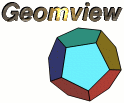 Home Overview FAQ Documentation Download Mailing List Geomview For Windows? Support Users Development Bug Reporting Contributing Contact Us Sponsors
|
[Date Prev][Date Next][Thread Prev][Thread Next][Date Index][Thread Index] Re: more questions
> I try to create several cameras, each one in
> a different location looking at a different geom.
You can only control (interactively, with the mouse) things in the
ordinary world. "scene"s are a special feature; we didn't implement
interactive controls over them.
Still, you might be able to get the desired effect if you can construct
rotation/translation/etc. matrices yourself. Tell geomview something like:
(scene 1 { INST transform : T geom < cam-frame.quad})
(scene 2 { INST transform : T geom < cloom.0.list})
etc.
Then you specify the positioning matrix, applied to all those geoms, by
(repeatedly) defining the symbol T with:
(read transform { define T ... sixteen numbers ... })
For example a 30-degree rotation in the XZ plane followed by a translation
of 2 in Z would be (I think)
(read transform { define T
.866 0 .5 0
0 1 0 0
-.5 0 .866 0
0 0 2 0
})
Note that T is completely respecified each time it's defined; you need to
supply the absolute matrix, not an incremental one from the previous matrix.
To specify a camera's initial position, you can use
(window default { position ... })
before creating the camera. "default" specifies stuff for future cameras.
You can specify colors on the faces when you construct the
geometry; see "man 5 oogl", e.g. CQUAD format, which specifies
a color per vertex, or OFF which can specify a color per face.
You can't use the interactive color picker to choose per-face colors,
though.
|
||
|
Home | Overview | FAQ | Documentation | Support | Download | Mailing List Windows? | Development | Bug Reporting | Contributing | Contact Us | Sponsors |
|||
|
site hosted by |
|||